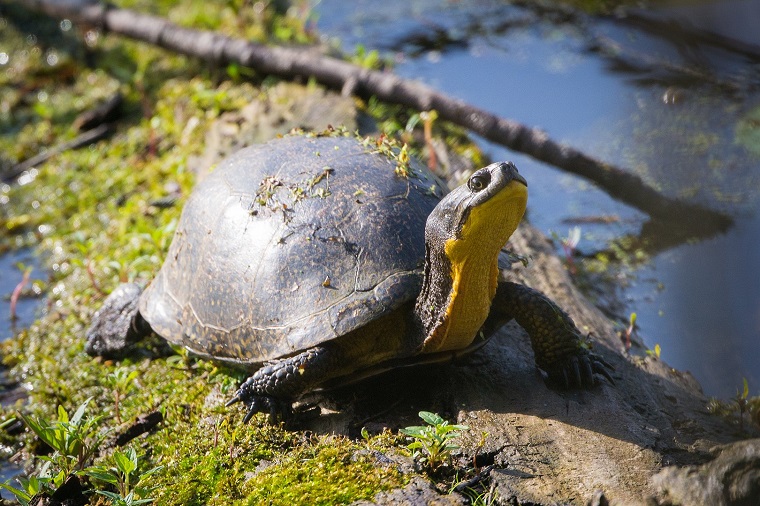eDNA: a Conservation Game-changer
By Olivia Balkwill
6 July 2021

eDNA technology successfully detected the presence of Blanding’s turtle, an at-risk species, in Kejimkujik
National Park (photo by Andrew Cannizzaro’ CC BY 2.0)
Scientists have a new tool to better monitor and manage invasive and at-risk species, and new research from the Department of Integrative Biology shows just how game-changing this new tool can be.
Environmental DNA (or eDNA) is DNA that is shed from an organism and collected from its environment, rather than from the organism itself. eDNA is commonly collected through water samples which are analyzed using advanced techniques to isolate trace amounts of DNA in the samples.
Dr. Robert Hanner and post-doctoral fellow Tzitziki Loeza-Quintana recently set out to validate the efficiency and accuracy of using eDNA to better understand “habitat occupancy” of invasive and at-risk species in environments where traditional sampling is difficult, invasive or time-consuming.
Traditional sampling methods, such as observations using binoculars or electrofishing, are effective but have their limitations, especially if target populations are small.
“It’s hard to set up traps and capture your target organisms over multiple days, which may be needed to adequately sample a small population. eDNA is much faster and more efficient,” says Hanner. “It significantly widens the window of sampling opportunity by eliminating the need to directly observe or interact with the species being monitored.”
Hanner and Loeza-Quintana focused on three aquatic species in and near Kejimkujik National Park, a 426 square kilometre biodiversity “hot spot” in Nova Scotia.
The park is home to a small, isolated population of Blandings turtle, which has been designated a species at risk. The park is also threatened by the proximity of two highly invasive fish species, chain pickerel and smallmouth bass, both of which are voracious predators feeding a range of prey, including turtle hatchlings. At the time of Hanner and Loeza-Quintana’s research, neither fish had yet been found within the park boundaries, but both species were established in nearby waterways.
“Once invasive species become established in an area, it is very expensive and difficult to eradicate them. This is why early detection of these species in protected areas like Kejimkujik is critical – so that rapid action can be taken,” says Hanner.
The team collected water samples from multiple locations within and just outside the park, and then analyzed them to see if they contained eDNA from any of the three target species.
eDNA from all three target species was found in almost all areas where the species had been previously recorded. Of greater interest yet to the researchers, however, was the fact that they also found eDNA evidence of the species outside of their previous recorded locations – including one new location for Blandings turtle, and the first record of chain pickerel and smallmouth bass within the park’s boundaries.
Kejimkujik National Park was an important site to test eDNA sampling because its lakes and rivers are highly acidic and rich in organic matter – two factors that can potentially limit the viability of eDNA in water samples.
But the study’s results showed that eDNA sampling passed the test with flying colours.
“eDNA performs as well or better than traditional sampling methods,” says Hanner.
The technology has potential far beyond the three species targeted by the research team.
“These tools are generating an incredible amount of interest among federal agencies such as Parks Canada and conservation organizations, where one of the main challenges facing conservation efforts to date has been a lack of data on both protected and invasive species alike.”
After seeing how useful eDNA was in monitoring Blandings turtles, chain pickerel and smallmouth bass at Kejimkujik, Parks Canada is now interested in eDNA monitoring of other species to help inform their management and conservation decisions.
Hanner highlights that eDNA can be also used in more than just aquatic ecosystems. “We are also collaborating with industry to look at eDNA in soil as well as water to help support mine closure plans and site restoration.”
The efficacy, wide applicability and reduced environmental impacts of eDNA surveys may be the answer to data-deficiency problems in conservation and help establish them as a widely used management technique in the years to come. And as DNA technologies become ever more sophisticated, expect to see the transformative potential of this exciting technology grow even further.
This study was funded by the Natural Sciences and Engineering Research Council and Parks Canada.
Read the full study in the journal Genome.
Read about other CBS Research Highlights.